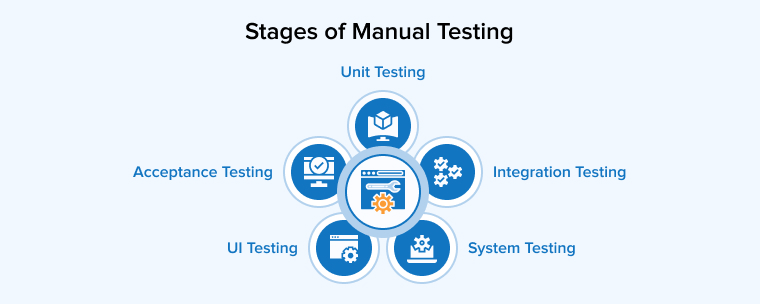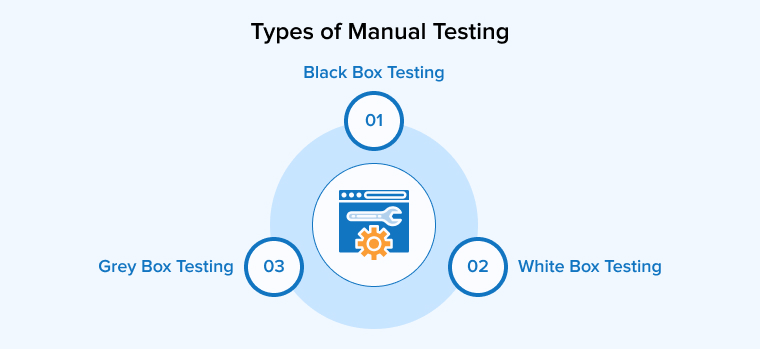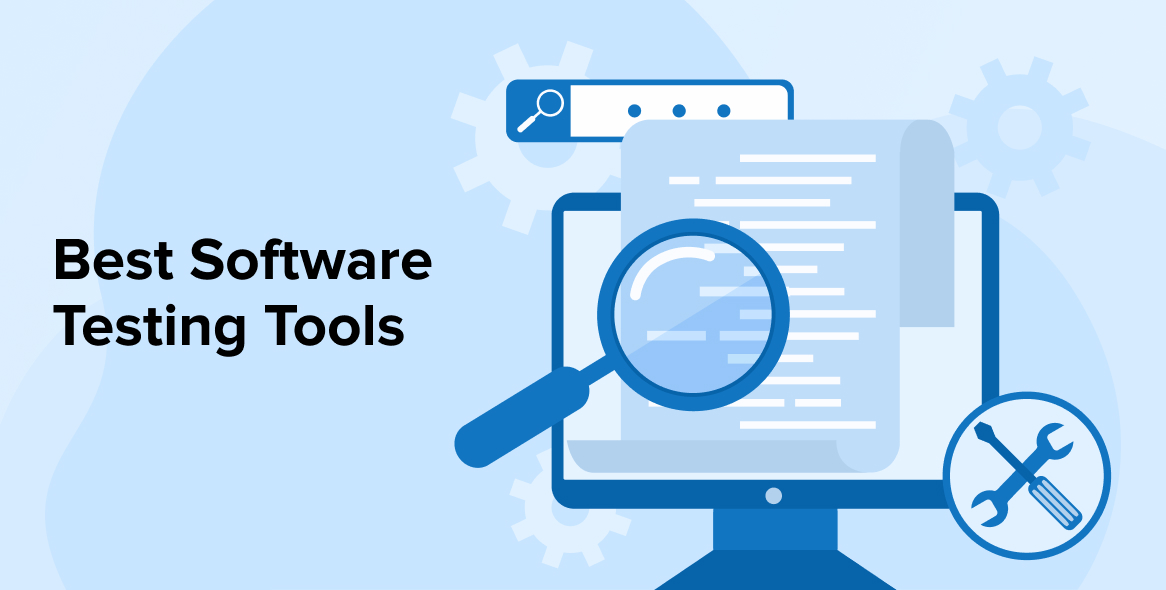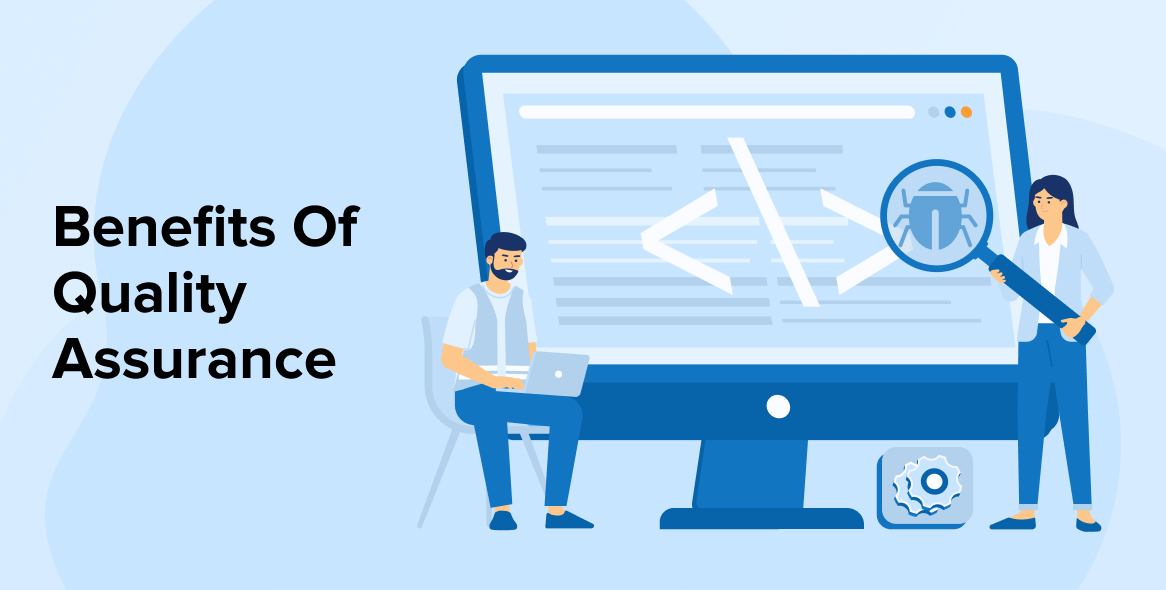
1. Introduction
Testing is a large subject area. When computer software is produced, it undergoes many software testing phases. The tests may be operational or non-operational, depending on the test needs.
Following are the 2 different approaches available to the QA services for software testing:
- Through manually running test cases as specified in the software testing process
- Through automating test cases with frameworks such as Selenium WebDriver
In a technologically sophisticated world wherein automated systems and frameworks make test engineers’ jobs simpler, it would be reasonable to think that manual testing has become outdated. It, nevertheless, is absolutely false.
If you’re wondering what manual testing is, this article will provide an exhaustive overview of manual testing. It will also assist readers in comprehending why manual testing cannot be entirely avoided.
2. What is Manual Testing?
Manual Testing is a type of software testing in which test cases are executed manually, with no assistance from automation testing tools. As part of this procedure, manual testers execute test cases manually while considering the end user’s perspective. The objective of Manual Testing is to uncover software application problems, faults, and flaws. Manual software testing is the most fundamental of all QA methods, and it assists in discovering significant software product faults.
For any software testing to be computerized, it must first be manually checked. Manual Software Testing involves more labor, but is required for determining the viability of automation. Manual Testing guidelines do not require acquaintance with any particular testing device. A basis of software testing is that 100% automation is impossible. But manual testing remains a most important part of software development.
3. Stages of Manual Testing

A software product undergoes the following manual testing phases. Developers initially test each testable software item, then combine individual pieces, and finally assemble the full system. However, at this step, system testing is conducted to ensure that the whole system conforms to the specifications.
After passing software system testing, the output is delivered to the client. After that client executes User Acceptance Testing prior to approving or rejecting a service.
3.1 Unit Testing
Unit testing is the developer-performed testing of single units and modules. A unit is the tiniest testable software component. Unit testing is often accomplished using a computer language and employs the white box testing approach. Before releasing the product to QA, it is imperative that the developers conduct unit testing.
Unit testing has various advantages. If you wish to conduct unit testing, you must employ a modular method of programming, which helps to make your program reusable and testing much simpler.
3.2 Integration Testing
It is conducted when multiple computer components, elements, and units are combined. The goal of the integration type of testing is to examine the modules’ performance, security, and dependability. The primary focus of integration tests is on technical areas that are explicitly or implicitly impacted by integration, like functionalities that accept input from one unit and create output in another.
3.3 System Testing
Software system testing is performed on a comprehensive, completely incorporated software product in order to assess the system’s behavior and conformance to its software requirements specification (SRS).
Due to the limited amount of time available, software system testing can be challenging. It is advised that you build your test environment equal to your operational setup and produce real-world information to ensure that the entire system satisfies the needs of the consumers.
Software testers perform different types of system testing like regression testing, functional testing, load testing, hardware, and software testing depending on specified functional requirements.
3.4 UI Testing
UI Testing, often referred to as GUI Testing, examines and validates the many user-facing parts of a software application. Manual Testing is especially for UI testing and ad hoc testing or exploratory testing. Where exploratory testing involves user interface, test design and test execution of application. Typically, this entails evaluating graphic aids to confirm that they adhere to usability and effectiveness specifications. UI Testing encompasses the entire spectrum of graphical markers and graphic-based symbols, including taskbar, typefaces, menus, input fields, buttons, and checklists among others. It guarantees that UI operations are error-free and functioning precisely as intended.
In addition to testing UI components, UI testing must consider different browsers, versions, and gadgets. People use the web from a variety of browser-device-operating system (OS) combinations; thus, the UI must present and perform flawlessly on all of them. In other terms, testing across many browsers must be an integral element of any UI testing approach.
3.5 Acceptance Testing
Acceptance Testing is the process that users conduct prior to accepting a software product. This testing often encompasses the real-world circumstances of the end customer. For this reason, UAT is conducted by users with varying responsibilities and permissions inside the system.
User acceptance testing must be conducted sensibly since the results will determine whether senior management approves or rejects the software product. You may feel compelled to develop a UAT test strategy to lead to user acceptability testing.
4. Types of Manual Testing
Here are the three types of manual testing that are suited to different software and environments.

4.1 Black Box Testing
Black-box testing is a strategy wherein the QA tester has no awareness of the software’s basic code or design. The QA engages with the software program in a manner identical to that of an end-user in order to verify its operational and non-operational behavior. This aids in discovering bugs that are ordinarily ignored in the early phases.
4.2 White Box Testing
White box testing is the process wherein the analyst is aware of the software’s coding and architecture. It is also referred to as transparent box testing. Engineers apply this to do unit testing.
Remember that white box testing is often employed by programmers and not by consumers. So, avoid becoming distracted by learning white box testing. Learn the distinction between black box and white box testing approaches and concentrate on refining your black box testing abilities. In the final phases of the profession, one may need to study white box testing in order to broaden the technical skills and increase the benefits to the company.
4.3 Grey Box Testing
Grey box testing is the blend of both black and white box testing. The purpose of gray box testing is to uncover faults and problems caused by the software’s structure or incorrect usage. Whenever you need to solve a significant problem in web services, you employ gray box testing. There are numerous technologies available to assist in the gray testing of apps.
As soon as we understand manual testing types, we move on to manual testing tools.
5. Manual Testing Tools
Following is a listing of the best manual software testing tools:

5.1 TestLink
If you are looking for a test management software, TestLink is for you.
5.2 Mantis
Mantis is the software testing tool which is mainly utilized in case of bug tracking via unauthorized sources as well as manual testing.
5.3 Postman
Postman is another example of tools which are exclusively useful for API testing and relatable things.
5.4 Firebug
If you are looking for an online debugger then you must consider this manual testing tool called Firebug.
6. How to Perform Manual Testing
Step 1: First, collect the specifications by using the assessment of the objectives stage. After you have gathered and comprehended the objectives, you expect an average performance, what you intend to analyze, and when the issue has been discovered.
Step 2: Once you have a thorough understanding of the objectives, you can select and design the test cases which will meet all of the needs outlined in the project specification. In particular, the test cases allow you to test features and multiple test situations sequentially, ensuring that you explore the complete system and verify the expected outcomes.
Step 3: When test cases are complete, the developer must evaluate them with the QA testing team manager and, if necessary, the customer. By evaluating the test cases, you will identify any bugs and fix them prior to running the test cases.
Step 4: After test cases are prepared and the test setup is established, you can perform each test case individually. Each test scenario would have one of the statuses listed below:
- Passed: If the tested scenario performs as intended.
- Failed: If the functioning is not as anticipated.
- Skipped: If the test scenario cannot be completed, it is skipped. It might be due to restrictions or unanticipated events.
Step 5: As the test scenarios operate, the found errors and flaws must be reported to the responsible developer and documented in a bug report.
Step 6: Lastly, you can prepare a thorough test report that includes data on the number of errors or problems discovered, the number of test scenarios that have to be repeated, the number of test cases that ended in failure, and the number of test cases that were skipped. After the faults and defects have been corrected, perform the test scenarios that were unable to validate the rectified bugs.
After comprehending the manual testing procedure, let’s examine the pros and cons of completing a manual test of the software being evaluated.
7. Tips for better Manual Testing
1. Understanding the requirements
For better and more effective manual testing, it is important to understand the requirements completely as it helps to improve the test coverage and the overall testing process.
2. Technical skill set
You must have technical skills such as the ability to query the database, knowledge of table structure and client-server architecture, and much more as it helps in the understanding of the app’s internal working and data flow as well as creating better test cases.
3. No assumption
More experienced testers take certain things for granted but it doesn’t matter whether the software is simple or complex, it must pass through the testing phase. So the tester should not assume that the software will software correctly even if it is not validating.
4. Having a good domain knowledge
It is necessary to have a good understanding of the domain as it helps in taking care of requirements that are not unspecified. For instance, a person who is aware of the e-commerce domain has the ability to effectively test any e-commerce application even if the set of requirements is limited.
5. Attention to detail
When you test software, make sure to pay attention to every small detail indulged in meticulously testing and check every feature of the application.
6. Good communication skill
As a software tester, you must deal with different stakeholders, fellow developers, managers, and sometimes with the client also. So make sure you have good communication skills to avoid any requirements gaps.
8. The Advantages of Manual Testing
Let’s examine some of the advantages of QA manual testing in software development.
- Manual testing aids in the detection of application problems prior to delivery to the client, hence preserving application grade.
- It helps in the timely detection of bugs. Bugs discovered by the client or even afterwards on the project’s development are tough to solve and raise the project’s expense. Consequently, manual testing that is executed well aids in preventing such scenarios by detecting problems early on.
- It aids in assuring compliance with both operational and non-operational criteria, including efficiency, readability, and user-friendliness.
9. The Disadvantages of Manual Testing
Let’s examine some of the disadvantages of QA manual testing in software development..
- Time-consuming: It is an extremely time-consuming method since software testers must construct thorough test scenarios and then run every testing step. In addition, the documenting of real test findings requires a while. Manual tests are not reusable so manual testers need to develop separate test cases for each software application development project.
- Requires additional resources: Contrary to automated testing, manual testing needs additional resources to generate and run test cases.
- Prone to human errors: Manual testing is susceptible to human error since it mainly depends on the competence or talents of the individual designing and running test cases. Even with established criteria and test methods, two analysts may arrive at different test outcomes depending on their comprehension.
- Not every test can be performed manually: Certain testing, such as performance testing, security testing, distributed testing and multithreaded operation testing can’t be performed efficiently without the use of test automation tools and security solutions.
10. Summary
In this post, we focussed on manual testing thoroughly. Beginning with the fundamentals of manual testing and going through the phases and techniques of manual software testing, we arrived at the software testing types and lastly its advantages and drawbacks.
Manual testing doesn’t quite preclude the usage of any instrument from aiding the testing process by software engineers. There are numerous test management technologies accessible on the marketplace to facilitate effective software testing.
The best manner to stay current in any profession is to follow relevant articles and notable figures in that profession. Likewise, we propose that you must also read a few software testing blogs on a daily basis so that you may continue learning and succeed in the testing profession. You can find many relatable blogs on our site and drop your valuable comments.






Comments
Leave a message...